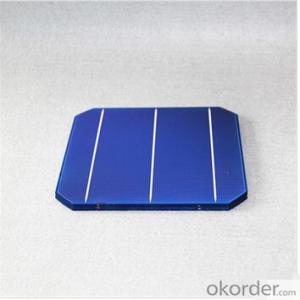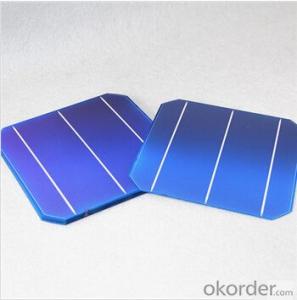High Quality Supply Monocrystalline Solar Cells
- Loading Port:
- Shanghai
- Payment Terms:
- TT or LC
- Min Order Qty:
- 1000 pc
- Supply Capability:
- 1000000 pc/month
OKorder Service Pledge
OKorder Financial Service
You Might Also Like
Solar Cells:
solar cells, when struck by photons of light from the sun, generates an electrical current which can then be used to power DC or AC electrical loads.
A solar cell is made of silicon. Computer chips are made of this same material. Basically, when light strikes the surface of a solar cell some of it is absorbed into the silicon. This light energy bumps the electrons loose and causes energy to flow
Solar cells is made by solar wafer, it has three categories of solar cell right now, monocrystalline polycrystalline and thin film,These cells are entirely based around the concept of PN junction, which is the critical part of solar module, it is the part that can convert the light energy into electricity, the thickness is from 180um to 200um, with even busbars to conduct electricity, textured cell can decrease diffuse reflection; they are often electrically connected and encapsulated as a module. Photovoltaic modules often have a sheet of glass on the front (sun up) side, allowing light to pass while protecting semiconductor wafers from abrasion and impact due to wind-driven debris, rain, hail, etc. Solar cells are also usually connected in series in modules, creating an additive voltage. Connecting cells in parallel will yield a higher current;With high quality and stable quality. Our Cells can greatly improve the performance of Solar Modules.
Features:
High efficiencies up to 16.4%
Proven long term mechanical stability of silicone
Make of highly purified poly silicone
Three bus bars for reduced series resistance and improved module and cell efficiency
Blue anti-reflecting coating ensures improved light absorption and increased efficiency
Acid texturization offers a uniform appearance and virtually invisible crystal structure
Excellent low light behavior for improved energy yield
Specifications
Efficiency code | Efficiency(%) | Pmax(w) | Impp(A) | Vmpp(V) | Isc(A) | Voc(C) |
196 | ≥19.6 | 4.68 | 8.56 | 0.547 | 8.99 | 0.643 |
194 | 19.4-19.6 | 4.64 | 8.51 | 0.545 | 8.96 | 0.641 |
192 | 19.2-19.4 | 4.59 | 8.46 | 0.542 | 8.93 | 0.639 |
190 | 19.0-19.2 | 4.54 | 8.42 | 0.539 | 8.90 | 0.637 |
188 | 18.8-19.0 | 4.49 | 8.35 | 0.538 | 8.86 | 0.635 |
186 | 18.6-18.80 | 4.44 | 8.33 | 0.533 | 8.84 | 0.631 |
Solar Cells Advantage:
1. High efficiency and High power.
2. Long-term electrical stability.
3. Lowest price and Fastest delivery.
4. Good quality and good service.
5.Bulk supply
6. Good Warranty
7.Big Sale

FAQ
We have organized several common questions for our clients,may help you sincerely:
1, What’s price per product ?
A: It’s depends on the quantity, delivery date and payment terms of the order. We can talk further about the detail price issue. Our products is high quality with lower price level.
2, How to make payment?
We accept T/T or L/C.
3, What is your lead time?
Generally 1-5 weeks depends on the order quantity and your specific requirements.
4, Can you do OEM for us?
Yes, we can.
5, How do you pack your products?
We have rich experience on how to pack the panels to make sure the safety on shipment when it arrives at the destination.
Applications of solar cell
A solar cell is an electrical device that converts the energy of light directly into electricity by the photovoltaic effect, which is a physical and chemical phenomenon.[2] It is a form of photoelectric cell, defined as a device whose electrical characteristics, such as current, voltage, or resistance, vary when exposed to light. Solar cells are the building blocks of photovoltaic modules, otherwise known as solar panels.
Solar pv Modules: the application of solar cell
A PV module consists of many PV cells wired in parallel to increase current and in series to produce a higher voltage. 36 cell modules are the industry standard for large power production.
The module is encapsulated with tempered glass (or some other transparent material) on the front surface, and with a protective and waterproof material on the back surface. The edges are sealed for weatherproofing, and there is often an aluminum frame holding everything together in a mountable unit. In the back of the module there is a junction box, or wire leads, providing electrical connections.
There are currently four commercial production technologies for PV Modules:
Single Crystalline
This is the oldest and more expensive production technique, but it's also the most efficient sunlight conversion technology available. Module efficiency averages about 10% to 12%*
Polycrystalline or Multicrystalline
This has a slightly lower conversion efficiency compared to single crystalline but manufacturing costs are also lower. Module efficiency averages about 10% to 11%*
String Ribbon
This is a refinement of polycrystalline production, there is less work in production so costs are even lower. Module efficiency averages 7% to 8%*
Amorphous or Thin Film
Silicon material is vaporized and deposited on glass or stainless steel. The cost is lower than any other method. Module efficiency averages 5% to 7%*
Solar Panels: the application of solar cells
Solar Photovoltaic panels constitute the solar array of a photovoltaic system that generates and supplies solar electricity in commercial and residential applications. Each module is rated by its DC output power under standard test conditions, and typically ranges from 100 to 365 watts. The efficiency of a module determines the area of a module given the same rated output – an 8% efficient 230 watt module will have twice the area of a 16% efficient 230 watt module. There are a few solar panels available that are exceeding 19% efficiency. A single solar module can produce only a limited amount of power; most installations contain multiple modules. A photovoltaic system typically includes a panel or an array of solar modules, a solar inverter, and sometimes a battery and/or solar tracker and interconnection wiring.
- Q:How do solar cells handle electromagnetic interference?
- Solar cells are typically designed to be resistant to electromagnetic interference by incorporating shielding and filtering techniques. These measures help to minimize the impact of electromagnetic waves from external sources, ensuring that the solar cells continue to operate efficiently and produce electricity without interference.
- Q:How long does it take to install solar cells on a rooftop?
- The time required to install solar cells on a rooftop can vary depending on various factors such as the size of the system, the complexity of the installation, and the number of installers working on the project. On average, a residential rooftop solar installation can typically take anywhere from one to three days to complete. However, larger commercial or industrial installations may take longer, ranging from a few weeks to several months. It's always best to consult with a professional solar installer who can provide a more accurate estimate based on the specific project requirements.
- Q:Can I trust the suppliers for film solar that I found on alibaba ?
- From my own experience, I think they are pretty reliable because you can search all the information including the factory's address, product details, etc. all on the website.
- Q:Can solar cells be used in electric fences?
- Yes, solar cells can be used in electric fences. Solar cells are capable of converting sunlight into electricity, which can be used to power electric fences. This provides a cost-effective and environmentally-friendly alternative to traditional power sources for electric fences.
- Q:What is the environmental impact of solar cell production?
- The environmental impact of solar cell production is generally considered to be lower compared to other forms of energy production. While the production of solar cells does require the extraction and processing of raw materials, such as silicon, the overall carbon footprint and pollution associated with solar panel manufacturing is significantly lower compared to fossil fuel-based energy sources. Additionally, solar panels have a long lifespan and produce clean, renewable energy once installed, which helps offset the initial environmental impact of their production.
- Q:How long is the long cycle solar cell life?
- A look at the application of the environment, if the ambient temperature is high, then in general, to 25 degrees as a benchmark, each increased by 10 degrees, life-span reduced by half;
- Q:Can solar cells be used to power surveillance cameras?
- Yes, solar cells can be used to power surveillance cameras. Solar power can provide a reliable and sustainable source of energy for surveillance cameras, eliminating the need for traditional electrical wiring or frequent battery changes. Solar panels can capture sunlight and convert it into electricity, which can then be stored in batteries to power the cameras day and night. This makes solar-powered surveillance cameras an eco-friendly and cost-effective solution, particularly in remote or off-grid locations.
- Q:Can solar cells be used in electric fence systems?
- Yes, solar cells can be used in electric fence systems. Solar panels can generate electricity from sunlight, which can then be stored in batteries and used to power electric fences. This eliminates the need for a connection to the main power grid and makes electric fence systems more flexible and cost-effective in remote areas.
- Q:Are solar cells affected by electromagnetic interference?
- Yes, solar cells can be affected by electromagnetic interference. Electromagnetic interference can degrade the performance of solar cells by disrupting the flow of electrons and causing fluctuations in output power. However, proper shielding and grounding techniques can be implemented to minimize these effects and ensure optimal functioning of solar cells.
- Q:Are solar cells affected by shade?
- Yes, solar cells are significantly affected by shade. Even a small amount of shade can cause a significant decrease in the power output of solar cells.
1. Manufacturer Overview |
|
|---|---|
| Location | |
| Year Established | |
| Annual Output Value | |
| Main Markets | |
| Company Certifications | |
2. Manufacturer Certificates |
|
|---|---|
| a) Certification Name | |
| Range | |
| Reference | |
| Validity Period | |
3. Manufacturer Capability |
|
|---|---|
| a)Trade Capacity | |
| Nearest Port | |
| Export Percentage | |
| No.of Employees in Trade Department | |
| Language Spoken: | |
| b)Factory Information | |
| Factory Size: | |
| No. of Production Lines | |
| Contract Manufacturing | |
| Product Price Range | |
Send your message to us
High Quality Supply Monocrystalline Solar Cells
- Loading Port:
- Shanghai
- Payment Terms:
- TT or LC
- Min Order Qty:
- 1000 pc
- Supply Capability:
- 1000000 pc/month
OKorder Service Pledge
OKorder Financial Service
Similar products
New products
Hot products
Hot Searches
Related keywords


























